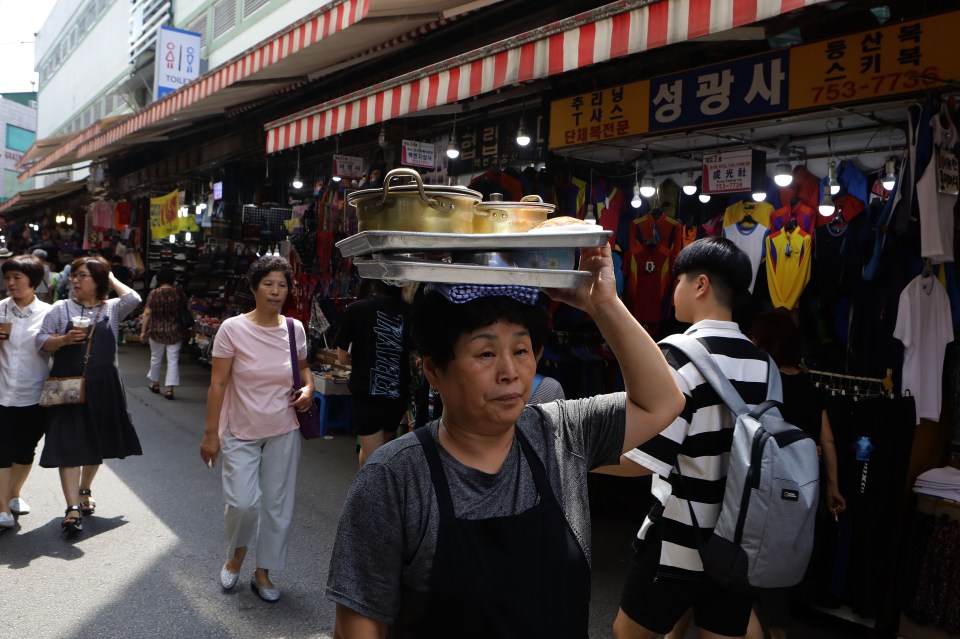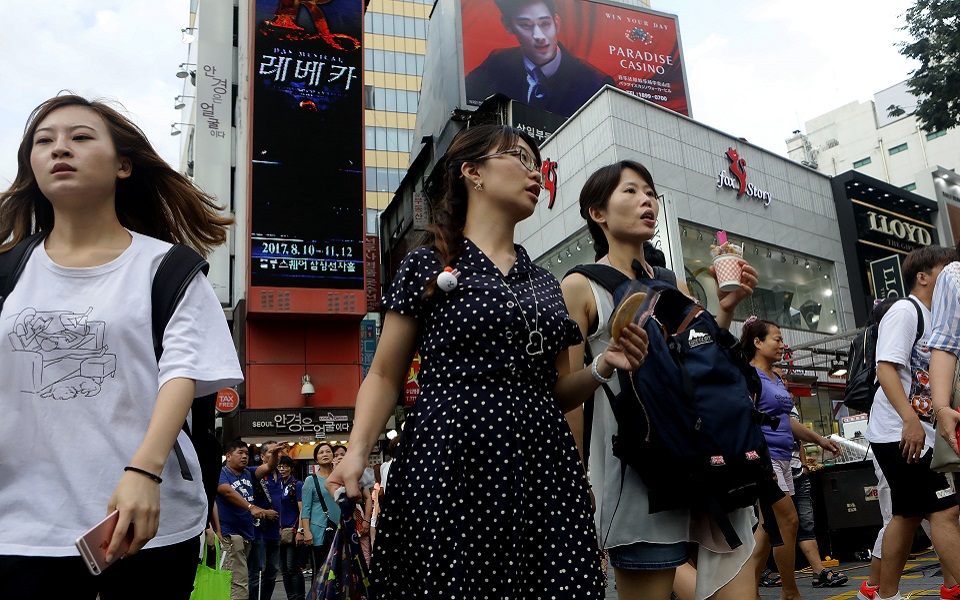Heart and Seoul in South Korea, as the nation reopens for tourism

The baby octopus floats in its tank, blissfully ignorant, until, all too soon, its time comes. The tiny, wrinkled old woman, who, I later learn, has been manning this particular food stall in Seoul’s colourful, noisy, aromatic Gwangjang market for over thirty-two years, yanks it out unceremoniously and whacks it down onto the steel surface. Then she whips out a knife almost bigger than she is and starts… chopping. Before long, this cute little cephalopod has been turned into a plateful of short, white, worm-shaped pieces; ready to be eaten, raw.
The main problem, for me at any rate, being that the whole heap keeps wriggling, exactly like worms, for well over ten minutes after the execution has taken place. Ignoring my rictus mask of horror as I observe the whole process, which takes no longer than about thirty seconds, she shoves the dish towards me, along with a pair of chopsticks and an assortment of condiments, and it’s all I can do not to shriek, ‘I’m a first-time visitor to South Korea – get me out of here…’
When it comes to Seoul’s fascinating and, shall we say, eclectic, food scene, I’ve been thrown right in at the deep end. This encounter is reminiscent of one of the more stomach-twisting scenes from Oldboy, a South Korean cult classic, in which, to be fair, the protagonist orally grapples with a raw octopus much bigger than this one. But, wherever I look, strange things are being sold, then scoffed, all around me. One of the most popular snacks is pancakes made of mung beans, the cooks enthusiastically scooping up balls of a gloopy mixture, throwing them in oil, then plating them up for the hungry queues. I try something I’m told is ‘fish on a stick’; the weird, long, bendy, rubbery item I’m handed bears no resemblance to any fish I’ve ever seen, or indeed tasted, but dipped in a spicy sauce it’s delightfully…chewy.

Then there’s ‘Korean raw beef’, their answer to beef tartare, served with an egg yolk on top to mix in, but also with shards of sliced pear to sweeten the deal. I decide I can stomach octopus served a different way, bibimbap style: fried in a spicy sauce with rice, and definitely not moving, it’s delicious.
Over the past few years, Korean food has taken off in London in a big way. Restaurants such as Jinjuu, Dotori and On the Bab have seen diners flocking to their doors, often braving massive queues. I’ve come to Seoul to try everything at source, and to soak up the atmosphere of the city that, last year, was the world’s sixth-most visited, beating New York. You can definitely feel the buzz; Bloomberg statistics reveal that South Korea is currently the most innovative country in the world, for industries including tech, cosmetics, even fashion.
Big brands like Estee Lauder, L’Oreal and Macys come here to learn, and to see how they can become more cutting edge by copying the leaders in the field. As well as its food, there’s a flourishing art scene, and in the music world, bright and bubbly K-pop – spearheaded by fresh-faced boy bands such as BTS – is fast permeating Western markets. Strolling around the hip, studenty neighbourhood of Hongdae is a bit of a trip. Harajuku-style boutiques jostle with restaurants, bars (and, brilliantly, even a meerkat café, which immediately makes Japan’s cat cafes look utterly pedestrian), as the city’s young and fashionable flock to the alluring maze of streets.

The look for Seoul’s men-about-town seems to involve shiny, black, mop top hairstyles, teamed either with long, black Crombie-style coats and polo-neck sweaters, or ankle length white padded duvet style jackets. Many women sport pale, chalky complexions teamed with red lipstick. Considering how big the beauty business is here – much of it centred in the teeming district of Myeongdong – no self-respecting Seoul girl would be seen looking anything less than perfection.
Thankfully they also love to eat, and from street food stalls at every corner, dispensing the likes of pork and kimchi dumplings, to high end, Michelin-starred restaurants in chi-chi neighbourhoods, the variety on offer is a delight. For my first proper meal, I’m going traditional. Seokparang is located in a historic building, the former summer house of the father of King Gojong of the Joseon dynasty, who ruled in the 19th century. Inside, the space is divided into different alcoves, and uniformed staff dispense tea and rice wine from heavy pots. The lengthy set menu starts with a congee-like glutinous porridge, then meanders through rice pancakes which are to be wrapped around fresh, crunchy, julienned vegetables; roast eel with shredded greens; plates of hot, sour kimchi; a dish of tender, short rib beef; glass noodles made from sweet potato…I have a feeling it ends with dates soaked in honey but by this point I’m not entirely sure.
This is probably how they dined at Seoul’s impressive Gyeongbokgang Palace, in the Jongno district, which I visit the following morning. Originally constructed of wood, it’s similar in shape and layout to Beijing’s Forbidden City, with hand-painted walls and roofs. In the front courtyard, among throngs of youths dressed up in South Korea’s traditional costume – hanbok, or billowing silk dresses for women, long coats and what look like top hats made of netting for the men – a very colourful changing of the guard is going on, with various groups of soldiers clad in bright reds, greens, yellows and blues.
Seoul’s heritage is striking, but the city’s modern side has equal appeal. The slick, upmarket neighbourhood of Gangnam, made famous by Psy’s ridiculously catchy Gangnam Style, is home to innovative, modern buildings, such as the Samsung D’Light, a steel and glass showcase for the brand’s current and future products, and SMTOWN, a bewildering, noisy, six-storey temple to all the K-Pop bands on the SM Entertainment music label. Later, I check out the Leeum Contemporary Art Museum in Itaewon, a beautiful, low-slung pavilion designed by starchitects Mario Botta and Jean Nouvel. Here, you’ll find works by Damien Hirst, D Kooning, Francis Bacon and Anish Kapoor, as well as displays of ceramics, scroll paintings and metalwork in the Korean art section.
That night, I have my most memorable meal yet, at Si.Wha.Dam in the area of Itaewon, which uses traditional Korean ingredients to create a very contemporary cuisine. Visual flourishes abound throughout the fantastically inventive 14-course seasonal set menu, from soybean porridge, to bulgogi (grilled meat) and short rib. The most moreish dish is the squid ink noodles in a cream and kimchi sauce; a savoury, spicy flavour explosion which makes me beg for the recipe.
Later, I bar hop around the city’s too-cool-for-school drinking scene. You can do anything from hang out in tiny record bars – lined with racks and racks of vinyl, generally tended to by rock fans in their sixties and seventies – like Suzie Q’s, or stumble into a speakeasy, like Hidden House in Hongdae, or the fabulously-named Pussyfoot Saloon in Hannam-dong. I finish the night at Charles H, the ‘secret’ bar in the basement of the Four Seasons hotel, a lush, 1920s-style mirrored oasis serving up the likes of Old Fashioneds made with coconut infused bourbon and almond liqueur. Like everything else in this city, it just whets my appetite for more. Apart from that raw octopus.
Need to know
Rooms at Conrad Seoul start from KRW 291,000 /£181; Grand King Executive Suites start from KRW 667,000 / £416, including with lounge access. To book visit the website or call +82 2-6137-7000. Asiana Airlines flies from LHR to Seoul from around £835 return in May